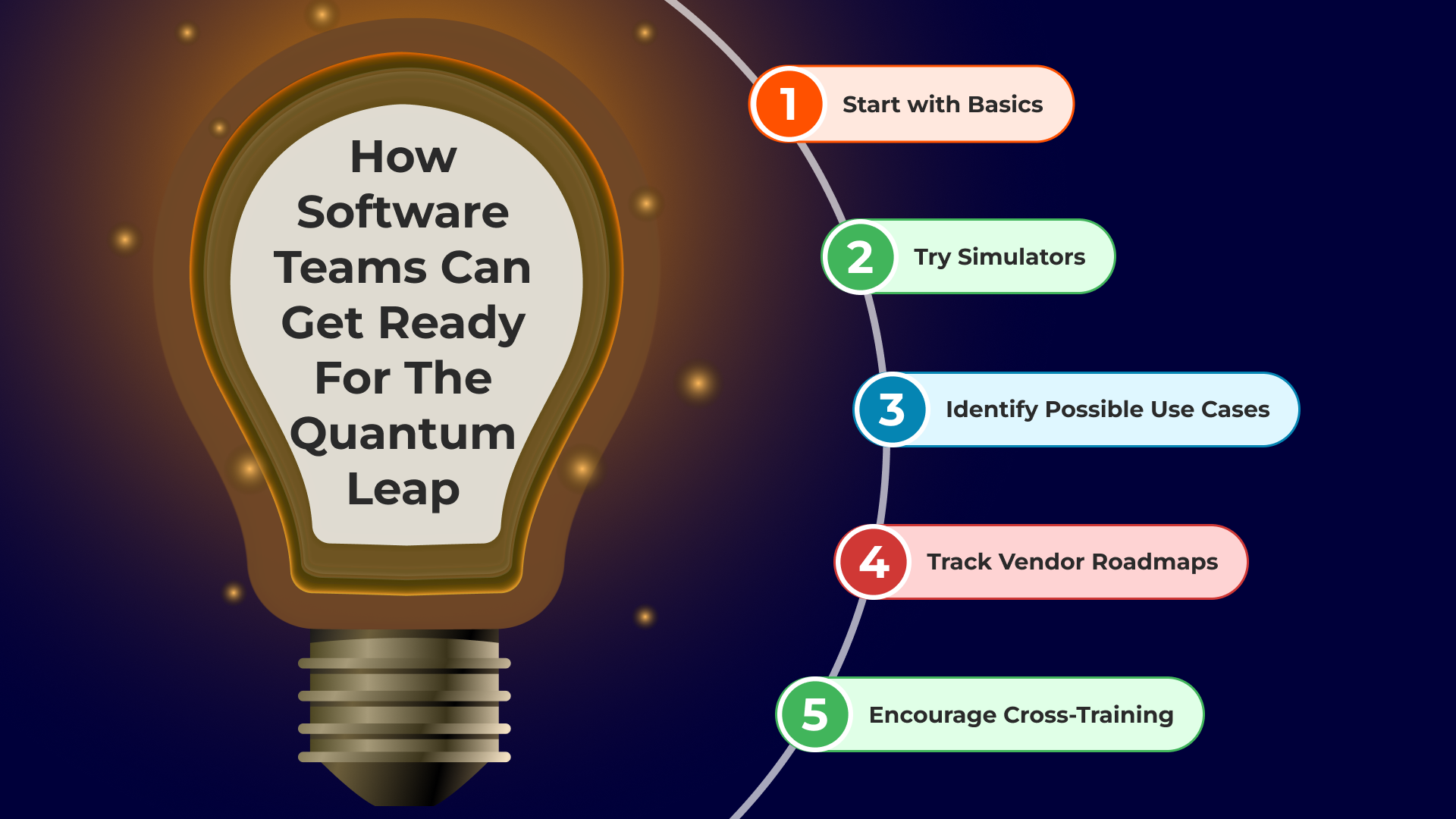
Quantum Computing in Software Development: Preparing for What’s Next
Last year, a product manager I know tried running a complex simulation on their cloud platform. The job failed again and cost them over 200 compute hours. They weren’t even close to the answer. He joked that if he had a machine from the future, it might have finished in time for the next board meeting. He wasn’t far off.
That conversation made me stop and rethink what’s ahead. We’re building faster servers, better software, and sharper models, but some problems still take too long. That’s where quantum computing steps in.
It’s not a replacement for what we have. Not yet. But it’s close enough now that your software team should be paying attention.
Let’s take a closer look at where quantum computing stands today, the tools you can use, how businesses are starting to apply it, what hurdles remain and what your team can do right now to get ahead.
State of Quantum Today: What It Is and Where It Stands
Traditional computers use bits, which are either 0 or 1. Quantum computers use qubits, which can be 0, 1, or both at once. That’s because of something called superposition. And when qubits affect each other, no matter how far apart, that’s called entanglement.
Put simply, quantum computers aren’t just faster; they think differently. That makes them powerful for solving problems that would take classical computers forever to work through, like modelling molecules or optimising huge systems.
But we’re not fully there yet. Right now, we’re in what’s called the NISQ era, Noisy Intermediate-Scale Quantum. Quantum computers exist, but they’re still fragile, error-prone, and only able to run small-scale experiments. Qubits lose their quantum state quickly (this is called decoherence), and they’re extremely sensitive to interference.
That said, progress is moving fast. Companies like IBM, Google, AWS, and Microsoft are investing billions into quantum research and cloud-based access.
For example:
-
IBM Quantum
Offers real quantum computers online for developers to try.
-
AWS Braket
Gives access to different quantum hardware vendors via one interface.
-
Azure Quantum
Lets you experiment with quantum algorithms directly in Microsoft’s ecosystem.
You don’t need to own hardware to try it. Services like IBM Quantum, AWS Braket, and Azure Quantum offer developer access to quantum processors through the cloud.
But how do you actually build quantum software? That’s where the right tools come in.
Technical Frameworks That Let You Build for Quantum
Quantum programming doesn’t have to start from scratch. Today’s SDKs and libraries give you a clear way to prototype, test, and simulate code, even if you’ve never worked on a quantum machine.
Here are the main platforms helping developers bridge theory and practice:
-
Qiskit (by IBM)
An open-source SDK based on Python. It is great for learning, simulating, and even running code on real IBM quantum machines.
-
Braket (by AWS)
A service that gives you access to different quantum backends (including IonQ and Rigetti) with one interface. You can build hybrid quantum/classical workflows and access managed notebooks.
-
Azure Quantum SDK:
Part of Microsoft’s ecosystem. It lets you build quantum apps using Q#, while managing classical-quantum operations through standard IDEs like Visual Studio Code.
-
Cirq (by Google)
A Python library tailored for near-term quantum algorithms. It focuses on fine-grained control and experimentation in the NISQ environment.
All these tools come with simulators to prototype workflows, meaning you can test logic and performance without needing a real quantum processor.
If you’re wondering whether these frameworks are useful now, the answer is yes. They’re already the backbone of most modern Qiskit development and early-stage enterprise quantum readiness programs.
And as these SDKs evolve, companies are already exploring where quantum delivers real value. But how can you actually use this in a real business?
How Enterprises Are Using Quantum Today
Quantum computing may still be early, but it’s not just stuck in research labs. Enterprises are already exploring areas where they can make a measurable difference.
Some of the first real applications include:
-
Optimization problems
Things like delivery routes, factory scheduling, portfolio rebalancing, and supply chain modelling.
-
Monte Carlo simulations
Proprietary frameworks, pre-built components, and a mature DevOps pipeline reduce delivery times when compared to industry averages. Clients benefit from faster ROI without compromising quality.
-
Drug discovery and materials science
Simulating atomic-level interactions more efficiently than classical computers ever could.
-
Machine learning
Applying quantum models to speed up certain types of pattern recognition.
At the U.S. Department of Energy’s National Energy Research Scientific Computing Centre (NERSC), more than 50% of current production workloads fall under areas like materials science, quantum chemistry, and high-energy physics, exactly the domains where quantum computing is expected to deliver major advantages.
These aren’t theoretical matches. They’re high-priority national computing tasks already being mapped to quantum pipelines as the technology becomes more stable. When a government lab flags that half its compute demand aligns with quantum-ready domains, that’s a strong indicator of what’s coming.
Let’s look at what this looks like in real life.
In a manufacturing setup, researchers applied quantum computing to a robotic assembly line task. They transformed the problem of balancing workstations across a production line into a model solvable by a hybrid quantum-classical algorithm. When tested using a D-Wave quantum computer, the solution helped reduce idle time and improved how tasks were distributed across the line.
Many of these companies are building hybrid architectures, mixing classical systems with quantum accelerators, to test real workloads. If your organization is building for scale, this is something to pay attention to.
And companies like Telliant Systems are helping forward-thinking software teams explore these quantum-powered opportunities inside existing development workflows.
The Challenges We Still Need to Solve
Quantum computing isn’t plug-and-play. It comes with some big hurdles, and these are the key challenges that developers and decision-makers should understand:
-
Error correction
Qubits are fragile. Even small noise can produce the wrong result. Fixing that is one of the hardest problems in quantum tech.
-
Short decoherence times
Quantum states collapse fast. If the system can’t complete a calculation before that happens, the result is lost.
-
Cost and scalability
Building stable machines is expensive and scaling them is non-trivial.
-
Talent shortage
Few developers understand quantum programming. The learning curve is steep.
-
Early-stage tools
SDKs are improving, but many libraries are still experimental, and there’s little standardisation across platforms.
But here’s the thing: you don’t need perfect hardware to start learning. Open-source SDKs like Qiskit, along with cloud-based tools like Braket and Azure Quantum, are helping close the gap.
And because the field is still young, there’s room to grow. Quantum isn’t replacing classical computing. But learning it now gives your team a major head start.
How Software Teams Can Prepare Now
You don’t need to be a physicist to get started. Here’s how teams can begin preparing for the quantum future right now:

-
Start with the basics
Learn quantum logic, circuits, and linear algebra. Sites like Qiskit.org have free, structured lessons.
-
Try simulators
Platforms like Qiskit, AWS Braket, and Azure Quantum SDK let you build and test circuits without hardware
-
Identify possible use cases
Look for optimization problems or simulation bottlenecks in your business that quantum could improve
-
Track vendor roadmaps
IBM, Microsoft, and AWS regularly publish updates on hardware progress and language improvements.
-
Encourage cross-training
Classical and quantum developers can learn from each other. Building those bridges now makes adoption easier later.
The future of software isn’t about replacing what you already do; it’s about expanding what’s possible.
If you’re building modern systems and planning for scale, Telliant systems can help you prepare for quantum-driven opportunities.
Don’t Wait for Perfect Conditions
Quantum computing in software development isn’t a distant dream. It’s already shaping how we think about hard problems, and how we solve them faster, better, and more creatively.
The tools are ready. The platforms are growing. And the teams that start learning today will be tomorrow’s leaders.
Quantum computing in software development isn’t about waiting for perfect machines; it’s about building the knowledge to use them when they arrive.






































